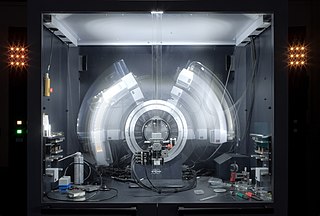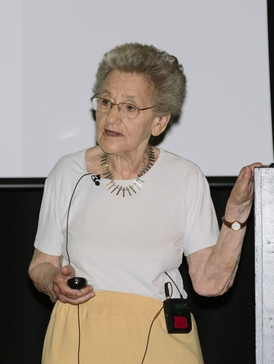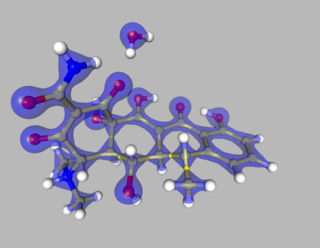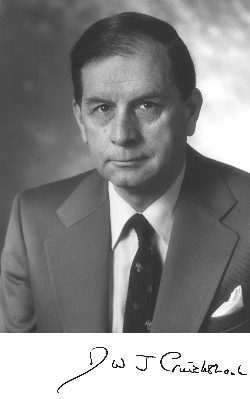Related Research Articles

X-ray crystallography is the experimental science of determining the atomic and molecular structure of a crystal, in which the crystalline structure causes a beam of incident X-rays to diffract in specific directions. By measuring the angles and intensities of the X-ray diffraction, a crystallographer can produce a three-dimensional picture of the density of electrons within the crystal and the positions of the atoms, as well as their chemical bonds, crystallographic disorder, and other information.

Olga Kennard, Lady Burgen was a Hungarian-born British scientist who specialised in crystallography. She was the founder of the Cambridge Crystallographic Data Centre.

Crystallographic Information File (CIF) is a standard text file format for representing crystallographic information, promulgated by the International Union of Crystallography (IUCr). CIF was developed by the IUCr Working Party on Crystallographic Information in an effort sponsored by the IUCr Commission on Crystallographic Data and the IUCr Commission on Journals. The file format was initially published by Hall, Allen, and Brown and has since been revised, most recently versions 1.1 and 2.0. Full specifications for the format are available at the IUCr website. Many computer programs for molecular viewing are compatible with this format, including Jmol.
Multi-wavelength anomalous diffraction is a technique used in X-ray crystallography that facilitates the determination of the three-dimensional structure of biological macromolecules via solution of the phase problem.
The International Union of Crystallography (IUCr) is an organisation devoted to the international promotion and coordination of the science of crystallography. The IUCr is a member of the International Council for Science (ICSU).
Acta Crystallographica is a series of peer-reviewed scientific journals, with articles centred on crystallography, published by the International Union of Crystallography (IUCr). Originally established in 1948 as a single journal called Acta Crystallographica, there are now six independent Acta Crystallographica titles:
Eleanor Joy Dodson FRS is an Australian-born biologist who specialises in the computational modelling of protein crystallography. She holds a chair in the Department of Chemistry at the University of York. She is the widow of the scientist Guy Dodson.

Mamannamana Vijayan was an Indian structural biologist.
Arthur William Pryor was an Australian physicist known for his contributions to neutron diffraction and infrared laser isotope separation. Pryor authored and co-authored a number of papers in the field of crystallography and he also co-authored, with B. T. M. Willis, the book Thermal Vibrations in Crystallography.

Randy John Read is a Wellcome Trust Principal Research Fellow and professor of protein crystallography at the University of Cambridge.
In crystallography, mosaicity is a measure of the spread of crystal plane orientations. A mosaic crystal is an idealized model of an imperfect crystal, imagined to consist of numerous small perfect crystals (crystallites) that are to some extent randomly misoriented. Empirically, mosaicities can be determined by measuring rocking curves. Diffraction by mosaics is described by the Darwin–Hamilton equations.

The Multipole Density Formalism is an X-ray crystallography method of electron density modelling proposed by Niels K. Hansen and Philip Coppens in 1978. Unlike the commonly used Independent Atom Model, the Hansen-Coppens Formalism presents an aspherical approach, allowing one to model the electron distribution around a nucleus separately in different directions and therefore describe numerous chemical features of a molecule inside the unit cell of an examined crystal in detail.
Quantum crystallography is a branch of crystallography that investigates crystalline materials within the framework of quantum mechanics, with analysis and representation, in position or in momentum space, of quantities like wave function, electron charge and spin density, density matrices and all properties related to them. Like the quantum chemistry, Quantum crystallography involves both experimental and computational work. The theoretical part of quantum crystallography is based on quantum mechanical calculations of atomic/molecular/crystal wave functions, density matrices or density models, used to simulate the electronic structure of a crystalline material. While in quantum chemistry, the experimental works mainly rely on spectroscopy, in quantum crystallography the scattering techniques play the central role, although spectroscopy as well as atomic microscopy are also sources of information.
Aafje Looijenga-Vos was a Dutch crystallographer. She was a professor for general chemistry and later for structural chemistry at the University of Groningen.

Theo Willem Jan Marie Janssen, better known as Ted Janssen, was a Dutch physicist and Full Professor of Theoretical Physics at the Radboud University Nijmegen. Together with Pim de Wolff and Aloysio Janner, he was one of the founding fathers of N-dimensional superspace approach in crystal structure analysis for the description of quasi periodic crystals and modulated structures. For this work he received the Aminoff Prize of the Royal Swedish Academy of Sciences in 1988 and the Ewald Prize of the International Union of Crystallography in 2014. These achievements were merit of his unique talent, combining a deep knowledge of physics with a rigorous mathematical approach. Their theoretical description of the structure and symmetry of incommensurate crystals using higher dimensional superspace groups also included the quasicrystals that were discovered in 1982 by Dan Schechtman, who received the Nobel Prize in Chemistry in 2011. The Swedish Academy of Sciences explicitly mentioned their work at this occasion.

Durward William John Cruickshank, often known as D. W. J. Cruickshank, was a British crystallographer whose work transformed the precision of determining molecular structures from X-ray crystal structure analysis. He developed the theoretical framework for anisotropic displacement parameters, also known as the thermal ellipsoid, for crystal structure determination in a series of papers published in 1956 in Acta Crystallographica.
This is a timeline of crystallography.
Alexander Frank Wells, or A. F. Wells, was a British chemist and crystallographer. He is known for his work on structural inorganic chemistry, which includes the description and classification of structural motifs, such as the polyhedral coordination environments, in crystals obtained from X-ray crystallography. His work is summarized in a classic reference book, Structural inorganic chemistry, first appeared in 1945 and has since gone through five editions. In addition, his work on crystal structures in terms of nets have been important and inspirational for the field of metal-organic frameworks and related materials.
Urea can crystallise with other compounds. These can be called urea adducts or if a solvent is involved, a urea solvate, and the process is called urea extraction crystallization. Urea can also be a neutral ligand if it is coordinated to a central metal atom. Urea can form hydrogen bonds to other oxygen and nitrogen atoms in the substance it crystallises with. This stiffens the solid and raises the melting point. T

Symmetry aspects of M. C. Escher's periodic drawings is a book by crystallographer Caroline H. MacGillavry published for the International Union of Crystallography (IUCr) by Oosthoek in 1965. The book analyzes the symmetry of M. C. Escher's colored periodic drawings using the international crystallographic notation.
References
- ↑ Hahn, Th.; Kurki-Suonio, K.V.J. (1986). "International Union of Crystallography announces the Ewald Prize". Acta Crystallographica Section B. 42 (4): 413–414. Bibcode:1986AcCrB..42Q.413.. doi:10.1107/S0108768186098014.
- ↑ Hargittai, I.; Hargittai, B.; Berend, I. T. (2023). Brilliance in exile: the diaspora of Hungarian scientists from John von Neumann to Katalin Karikó. Budapest: Central European University Press. p. 170. ISBN 9789633866078.
- ↑ Mole, Beth (16 October 2014). "Crystallography celebrates centennial". Science News.
- ↑ Goldbaum, E. (2005-02-15). Coppens to receive prestigious international Ewald Prize
- ↑ Woolfson, M.M. (1996). "Book Reviews: The gentle pioneer". Notes and Records of the Royal Society of London. 50 (2): 263–264. doi:10.1098/rsnr.1996.0034. S2CID 123312705.
- ↑ Anon. (2019-02-11). Celebrating crystallography at Birkbeck
- ↑ Senechal, Marjorie (2015). "Mathematical crystallography in the 21st century". Zeitschrift für Kristallographie - Crystalline Materials. 230 (12): 691–698. doi:10.1515/zkri-2015-1870. S2CID 99422981.
- ↑ "The Ewald Prize". Acta Crystallographica Section B. 43 (4): 407. 1987. Bibcode:1987AcCrB..43..407.. doi:10.1107/s0108768187097623.
- ↑ "The Ewald Prize". Acta Crystallographica Section A. 43 (4): 588. 1987. Bibcode:1987AcCrA..43..588.. doi:10.1107/s0108767387098957.
- ↑ J.M. Cowley and A.F. Moodie awarded the first Ewald Prize
- ↑ B.K. Vainshtein awarded the second Ewald Prize
- ↑ N. Kato awarded the third Ewald Prize
- ↑ M.G. Rossmann awarded the fourth Ewald Prize
- ↑ G.N. Ramachandran awarded the fifth Ewald Prize
- ↑ "Ewald Prize awarded to Professor Michael Woolfson". Acta Crystallographica Section A. 58 (3): 302. 2002. doi:10.1107/s0108767302005573.
- ↑ M.M. Woolfson awarded the sixth Ewald Prize
- ↑ "Ewald Prize awarded to Professor Philip Coppens". Acta Crystallographica Section A. 61 (2): 300. 2005. doi:10.1107/s0108767305005131. PMID 15724078.
- ↑ P. Coppens awarded the seventh Ewald Prize
- ↑ "Ewald Prize Award". Acta Crystallographica Section A. 64 (2): 352. 2008. doi:10.1107/s0108767308002572. PMID 18285634.
- ↑ "Ninth Ewald Prize". Acta Crystallographica Section A. 67 (4): 419. 2011. Bibcode:2011AcCrA..67..419D. doi:10.1107/s0108767311018526.
- ↑ A. Janner and T.W.J.M. Janssen awarded the tenth Ewald Prize
- ↑ Mukhopadhyay, N. K. (2014). "The Tenth Ewald Prize and aperiodic crystals" (PDF). Current Science. 106 (6): 793.
- ↑ T. Blundell awarded the eleventh Ewald Prize
- ↑ O. Kennard awarded the twelfth Ewald Prize
- ↑ W.A. Hendrickson awarded the 13th Ewald Prize
- ↑ Hendrickson, Wayne A. (2023). "Facing the phase problem" (PDF). IUCrJ. 10 (5): 521–543. Bibcode:2023IUCrJ..10..521H. doi:10.1107/S2052252523006449. PMC 10478523 . PMID 37668214.
